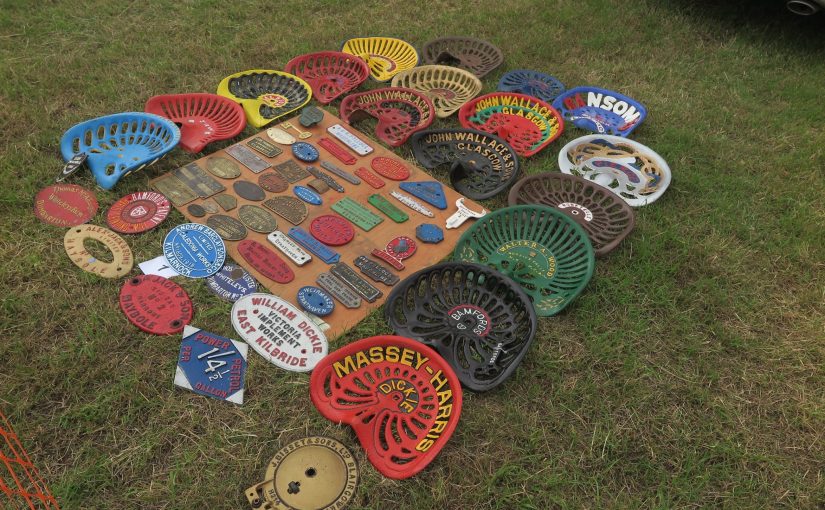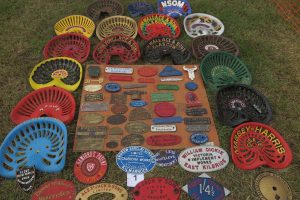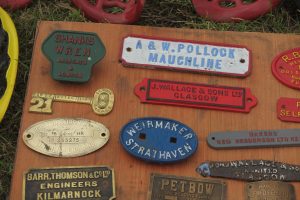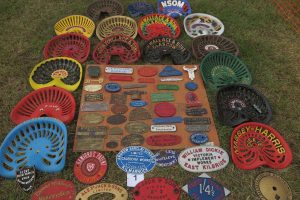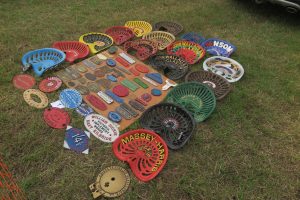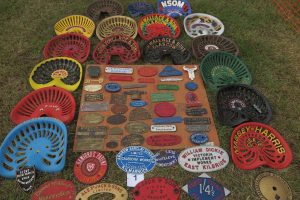Newspapers in Scotland carried extensive accounts of the Highland Show. These included extensive accounts of the implement stands, the new implements, the livestock displayed and the award winners. Because of the extent of the implement yard, accounts of it tended to be extensive, though the amount of space devoted to each stand was brief. They provide useful information for the historian today of agricultural implements and machines. Often they provide information in the absence of other sources. We have posted an account of the Highland Show in Inverness from The Scotsman. It set out what attracted its reporter.
Today, we include an account from the Aberdeen free press of 25 July 1892. This includes an extensive account on the development of mechanisation in the nineteenth century as well as key implements and machines. It refers to ones that were particularly important for the farmers in the north.
The account states:
“HAS Inverness 1892
Since the last show of the Highland Society was held at Inverness, great improvements have been effected on implements and machinery. Inventors never appear to tire of trying to bring out something new, as is well proved by the large number of patents that are applied for every day of the year; and when they find it impossible to invent new machines, many of them tax their brains to the utmost to improve in detail those that are in existence. In this latter respect abundant evidence is given at the Inverness show, a large amount of brain-power having been expended in taking advantage of the laws of nature towards improving and perfecting in the smaller details the implements and machinery used for agricultural purposes. In the minds of those who have often visited the Highland Society’s shows, and whose recollections can travel back well on to half a century of years, what an enormous contrast is presented! In those days the first sound that would have greeter the ear of many a farmer when he got early out of bed in a winter’s morning would have been, perhaps, the constant thud and whack of the flail from the surrounding barns of the smaller farmers and crofters; and if he had peered into the barns of the larger farmers about four or five o’clock in the morning, more than likely he would have found the farm servants busily engaged either in threshing or in dressing the corn by an old creaking fanner or “winnoster”, which might have been heard for a long distance off. The light by which the work would have been done would have been found to stand out in strong contrast again that of modern days, a “wick” made out of rushes and burning in “train” oil being considered a great improvement on the old and troublesome for sticks. The threshing mills, too, in those days were clumsy enough, and hard to drag, as the horses could well have testified, and the other implements of the farm were usually more unwieldy. The climax of science was considered to be reached when the skilled millwright was called in to do his part in putting in a mill. From small beginnings in the direction of improvement great progress has been made during the last twenty-five years, for even during that comparatively short period the most of the really useful modern agricultural implements have been brought forward and perfected. Reaping machines, when they were first seen, were almost laughed at, and the men who bought them were looked upon by a good many as faddists, and objections by the hundred were presented as to their ever coming into use. But what changes days and years can produce. The reaper and binder, which may not be looked upon as one of the greatest wonders on the farm, was looked upon but a very few years ago as a machine which might possibly be adapted to cut down the wheat of the prairie lands, but it looked like an idle dream to suppose that it could ever come into ordinary use. Last year a large number of farmers were “converted”, as the public trials which took place at various centres over the country the binders amid twisted corn performed their work in many cases better than the man with his scythe could do, and it was almost a debateable point if it could not even compete with many of the back or side-delivery reapers. The old objection, too, was also almost overborne that a pair of good hardy horses could not pull the machine, as it was acknowledged by many that they could do so with ease and without almost turning “a hair”. The other objection as to price is being gradually removed, as the scale of being lowered, and the weight of many of the machines has in many cases now descended to about half a ton.
On entering the gate, the first thing that will appeal to the eye and greet the ear will be the immense array of labour saving implements and the roar of machinery performing work, from driving sewing machines, to threshing and grinding mills, will all alike demonstrate that progress of a very marked character is being made. As showing in marked contrast side by side the rate of progress made, a mill may be seen at work near the entrance gate driven by a powerful engine grinding grain, while in a recess of the machine the electric light flashes out its brilliant light as if trying to compete with a still more powerful luminary overhead. A rapid survey of the showyard will show that inventors are striving hard to put “steam” itself as a motive agent in the background, as gas and electricity are not only now strong competitors where only a few horse power is required, but an engine is shown on the ground of about ten horse power, which is driven by petroleum, the oil being first heated then exploded like gas. Descending the scale to details, the improvements that have been effected on all kinds of machines are legion, and all tending in the direction of lightening labour and of making the work more easily and effectively performed. The hook has given place to the reaper and binder, the flail to the “tiny” threshing machine, the “rashen” wick to petroleum, gas, or the electric light, and all round abundant evidence is afforded that, great as the improvements are, the end of the century will only usher in another age which will be “yet much more wonderful”. Among those in the dim and distant future, as concentrating almost within itself one of the potentialities, electricity will more than likely play an important part, while the explosive forces-the tides, the waves, and the waterfalls-will be put in harness and compelled to do their quota of work.
Messrs G. W. Murray & Co, Banff Foundry, Banff, at their stand, no. 25, show a large and varied assortment of agricultural implements. The Company are agents for the celebrated Toronto steel binder, which ahs gained for itself an excellent reputation in the past as a machine which will cut all conditions of crop, and give purchasers entire satisfaction. It is light in draught, and easily within the power of two horses. In practice it is a machine which requires little repairs, as it is made of malleable iron and steel. They also show their famed Victory Reaper, which has been well known for many years over Scotland, and this season several important improvements have been effected. The demand has been so great this season that unless farmers place their orders early they will run the risk of being disappointed. The firm also call special attention to their one horse reapers, which will be found very suitable for small farmers in the north, as they are light in draught and quite within the power of a single horse, or if two horses are available they can be attached if desired. They exhibit a good selection of drill and swing ploughs of various patterns for one and two horses. The drill ploughs have steel boards, and the workmanship if the whole is highly finished. They also show one and two horse chain pumps, corn bruisers of various sizes, and last, but not lease, their celebrated Victory knife grinder, which can be driven by hand or foot. They also show several hand, horse, and water- power threshing mills of their own manufacture, which they warrant to do the work in a satisfactory manner. Murray’s turnip-sower, potato planter, and their new three-tined grubber are likely to attract attention. They also act as agents for the sale of Massey, Harris, & Co’s “Sharp” hay rake, of which it is stayed forty thousand have been made, and the demand for them this season in the north has been exceptional, owing to their ability and cheapness.
Stand no. 33 is occupied by George Sellar and Son, Huntly, with an exhibit of their implements. Part of their stand was shown at Aberdeen, and was fully described by us in our report of the Royal Northern Society’s Show. The chief feature of the stand is their display of ploughs, which are shown in every variety, with mould boards varying in length from 4 feet to 2 feet in length. The introduction of Anglo-American ploughs had the effect of shaking the confidence of farmers in ploughs with long boards, and the demand has now settled down for a good, strong, swing plough, with a medium length of board, as represented by their no. 27. This is a plow which can be turned to all sorts and conditions of work, is light in draught, and does not leave the furrow slice too cohesive and plastered up. The long boards, such as no. 29, have been relegated to ploughing matches. Two samples of steel grubbers are shewn-made of steel throughout. The advantage of steel in the construction of grubbers is that when the implement strikes a stone, steel will, although bent, spring bank into its original position, while iron, on the other hand, remains bent. The grubber thus getting off the truth, gradually gets worse until it has to be refitted again by the blacksmith. The harrow made by this form are also of steel, without any bolts in them. The turnip sower which they exhibit seems to have been in some measure remodelled. It looks much more compact and in every way lighted. The rollers are self-shifting, to any size of drill, and the seed can be seen passing from the seed boxes into the pipes, so that no mistake can occur with the seed stopping. The Johnston binder is also shown on this stand, which, along with the others, require to be thoroughly tested before their good qualities can be confirmed. Altogether this stand is attractive, and ought to command some attention.
Thomas Gibson & Son, Bainfield Ironworks, Edinburgh, at stand no. 39, have a large space allotted to them, and their entries, numbering 135 in all, occupy several pages of the catalogue. The goods are all of their own manufacture, and in a number of the articles shown they claim originality in construction and design. One of the principal features in this stand is the new patent channel iron fence, with wood top-rail, the latter making the fence much more visible for hunting, and less dangerous on the side of public roadways than ordinary iron fences. They also exhibit a tripod tree guard, invented by Mr A. A. McLeod, park superintendent, Edinburgh. The tree is surrounded inside the guard by close wire-mesh netting, seven inches in diameter, making the guard entirely rabbit-proof. The price is very moderate. They also show a new and improved con rick stand, with improving air-bossing, an arrangement which would enable farmers to take in their crops when wet, and it is also of the greatest advantage in respect that in wet seasons the grain of fodder won’t heat, this being prevented by the free access of air to the stack.
The Bisset back-delivery reaper have for years been well to the front of the north, and at stand no. 5 Messrs J. Bisset & Sons, Blairgowrie, show a good collection of their “Speedwell” self-acting, back-delivery reaper. They also show their Bisset Binder, which was described at the Aberdeen show, the principal features of which is that there is no “canvass” required, the grain being conveyed on an endless spiked chain.
